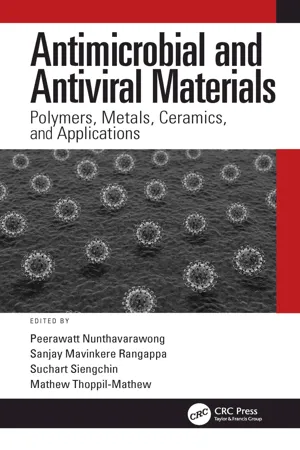
Antimicrobial and Antiviral Materials
Polymers, Metals, Ceramics, and Applications
- 250 pages
- English
- ePUB (mobile friendly)
- Available on iOS & Android
Antimicrobial and Antiviral Materials
Polymers, Metals, Ceramics, and Applications
About this book
Emerging microbial and viral infections are a serious challenge to health, safety, and economics around the world. Antimicrobial and antiviral technologies are needed to disrupt the progression and replication of bacteria and viruses and to counter their rapidly evolving resistance. This book discusses recent developments in materials science and engineering in combating infectious diseases and explores advances in antimicrobial and antiviral materials, including polymers, metals, and ceramics and their applications in the fight against pathogens.
Features
• Covers progress in biomimetic antimicrobial and antiviral materials and antimicrobial/antiviral bulk materials and coatings
• Describes modern methods for disinfection of biomedical materials against microbial and viral infection resistance, especially for depressing novel coronavirus (COVID-19)
• Details methods to improve material properties to have a longer service life in combating infection
• Emphasizes chemical, physical, mechanical, tribological, and antimicrobial/antiviral properties • Offers current and future applications of emerging antimicrobial/antiviral technologies
This book will be of interest to materials researchers and industry professionals focusing on antimicrobial and antiviral applications.
Frequently asked questions
- Essential is ideal for learners and professionals who enjoy exploring a wide range of subjects. Access the Essential Library with 800,000+ trusted titles and best-sellers across business, personal growth, and the humanities. Includes unlimited reading time and Standard Read Aloud voice.
- Complete: Perfect for advanced learners and researchers needing full, unrestricted access. Unlock 1.4M+ books across hundreds of subjects, including academic and specialized titles. The Complete Plan also includes advanced features like Premium Read Aloud and Research Assistant.
Please note we cannot support devices running on iOS 13 and Android 7 or earlier. Learn more about using the app.
Information
1 Introduction to Antimicrobial and Antiviral Materials
CONTENTS
- 1.1 Introduction
- References
1.1 INTRODUCTION
REFERENCES
- 1. Muñoz-Bonilla, A., & Fernández-García, M, (2012). Polymeric materials with antimicrobial activity. Progress in Polymer Science, 37(2), 281-339. DOI:10.1016/j.progpolymsci.2011.08.005.
- 2. Mallakpour, S., Azadi, E., & Hussain, C. M. (2021). Recent breakthroughs of antibacterial and antiviral protective polymeric materials during COVID-19 pandemic and postpandemic: Coating, packaging, and textile applications. Current Opinion in Colloid & Interface Science, 101480. DOI:10.1016/j.cocis.2021.101480.
- 3. Jarach, N., Dodiuk, H., & Kenig, S. (2020). Polymers in the medical antiviral frontline. Polymers, 22(8), 1727. DOI:10.3390/polym12081727.
- 4. Makvandi, P., Wang, C. Y., Zare, E. N., Borzacchiello, A., Niu, L. N., & Tay, F. R. (2020). Metal-based nanomaterials in biomedical applications: Antimicrobial activity and cytotoxicity aspects. Advanced Functional Materials, 30(22), 1910021. DOI:10.1002/adfm.201910021.
- 5. Zare, E. N., Jamaledin, R., Naserzadeh, R, Afjeh-Dana, E., Ashtari, B., Hosseinzadeh, M., . . . Makvandi, P. (2019a). Metal-based nanostractures/PLGA nanocomposites: Antimicrobial activity, cytotoxicity, and their biomedical applications. ACS Applied Materials & Interfaces, 72(3), 3279-3300. DOI:10.1021/acsami.9b19435.
- 6. Parham, S., Kharazi, A. Z., Bakhsheshi-Rad, H. R., Nur, H., Ismail, A. F., Sharif, S., ... Berto, F. (2020). Antioxidant, antimicrobial and antiviral properties of herbal materi als. Antioxidants, 9(12), 1309. DOI:10.3390/antiox9121309.
- 7. Abd-El-Aziz, A. S., Agatemor, C., & Etkin, N. (2017). Antimicrobial resistance challenged with metal-based antimicrobial macromolecules. Biomaterials, 118, 27-50. DOI:10.1016/j.biomaterials.2016.12.002.
- 8. Pemmada, R., Zhu, X., Dash, M., Zhou, Y., Ramakrishna, S., Peng, X., & Nanda, H. S. (2020). Science-based strategies of antiviral coatings with viricidal properties for the COVID-19 like pandemics. Materials, 73(18), 4041. DOI:10.3390/ma13184041.
- 9. Balasubramaniam, B., Prateek, R. S., Saraf, M., Kar, P, Singh, S. P., . . . Gupta, R. K. (2020). Antibacterial and antiviral functional materials: Chemistry and biological activity toward tackling COVID-19-like pandemics. ACS Pharmacology & Translational Science, 4(1), 8-54. DOI:10.1021/acsptsci.0c00174.
- 10. Pan, Y., Xia, Q., & Xiao, H. (2019). Cationic polymers with tailored structures for rendering polysaccharide-based materials antimicrobial: An overview. Polymers, 77(8), 1283. DOI:10.3390/polym11081283.
- 11. Wang, Y., Canady, T. D., Zhou, Z., Tang, Y., Price, D. N., Bear, D. G., . . . Whitten, D. G. (2011). Cationic phenylene ethynyletie polymers and oligomers exhibit efficient antiviral activity. ACS Applied Mater...
Table of contents
- Cover
- Half Title
- Title
- Copyright
- Contents
- Preface
- Acknowledgments
- List of Author/Editor Biographies
- Chapter 1 Introduction to Antimicrobial and Antiviral Materials
- Chapter 2 Recent Advances in Materials Science and Engineering Contributing to the Infection Diseases
- Chapter 3 Larvicidal and Antimicrobial Activities of Green-Synthesized Ag Nanoparticles
- Chapter 4 Biofilms and Materials’ Infectivity
- Chapter 5 Preparation, Characterization, and Applications of Polymer Nanocomposite Films and Fabrics with In Situ Generated Metal Nanoparticles by Bioreduction Method
- Chapter 6 Antibacterial Ceramics: The Past, Present, and Future
- Chapter 7 Materials Characterization Using Advanced Synchrotron Radiation Techniques for Antimicrobial Materials
- Chapter 8 Emerging Antiviral Technology
- chapter 9 Antimicrobial/Antiviral Nano-TiO2 Coatings for Medical Applications
- Chapter 10 Conducting Polymer Soft Actuators and Their Applications
- Chapter 11 The Recent Development of Antiviral Cold-Sprayed Copper Coatings against Coronavirus Disease Infection
- Index